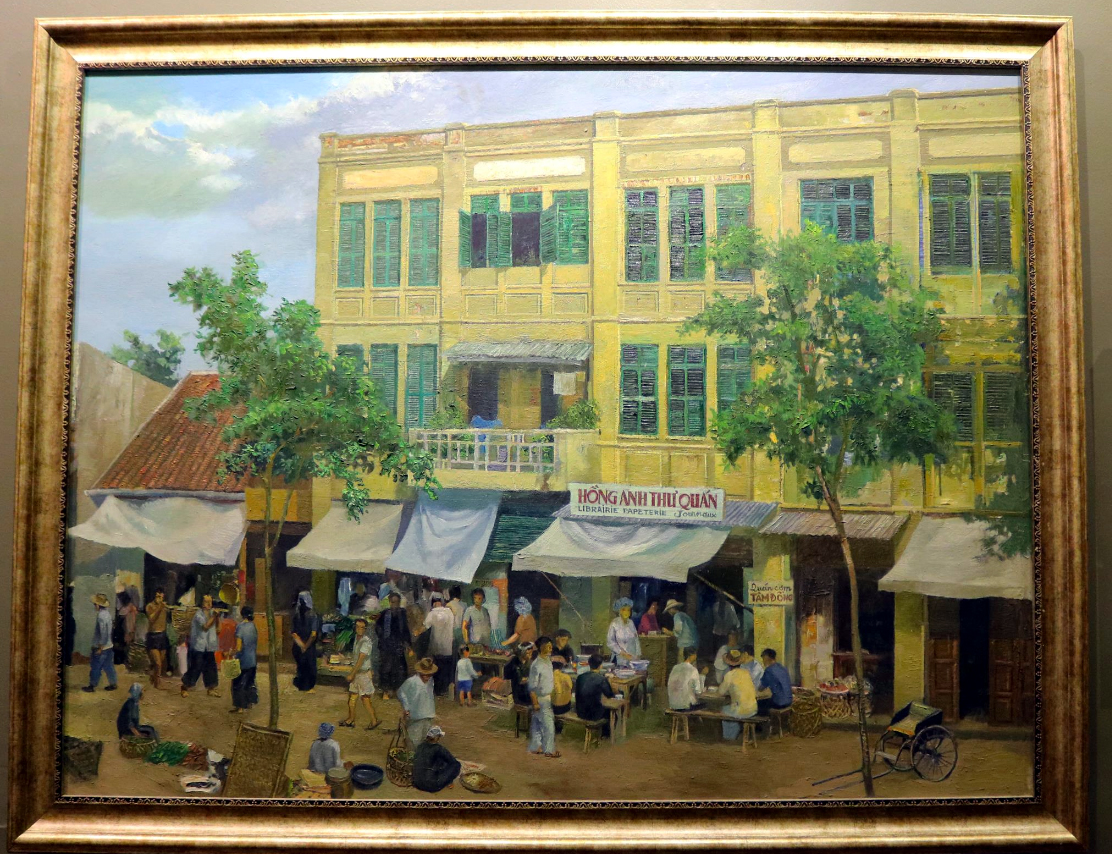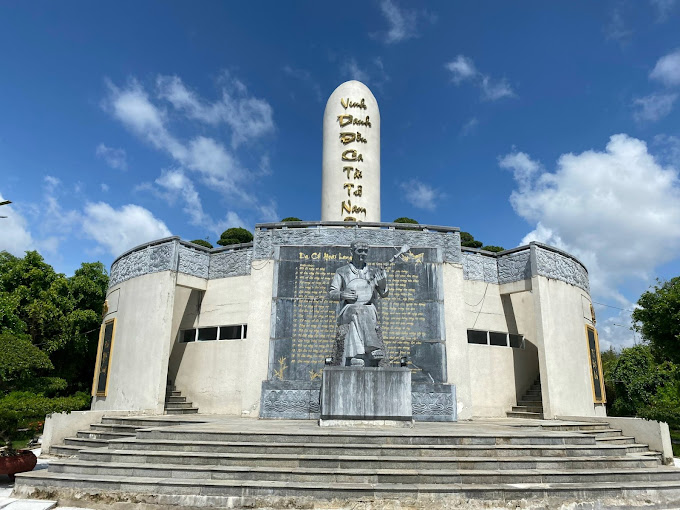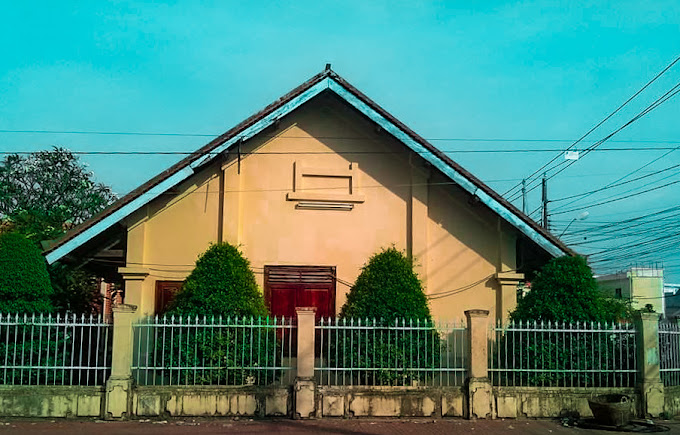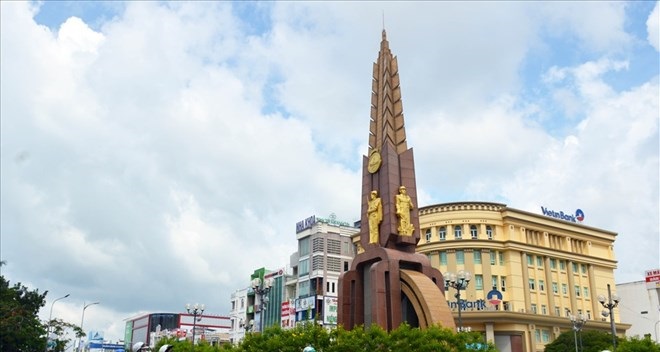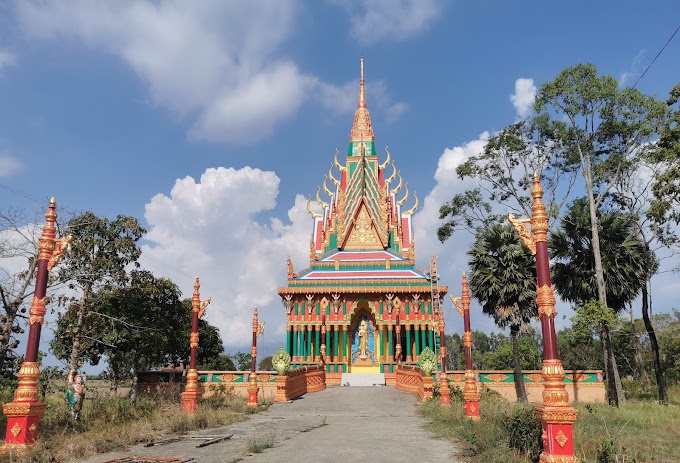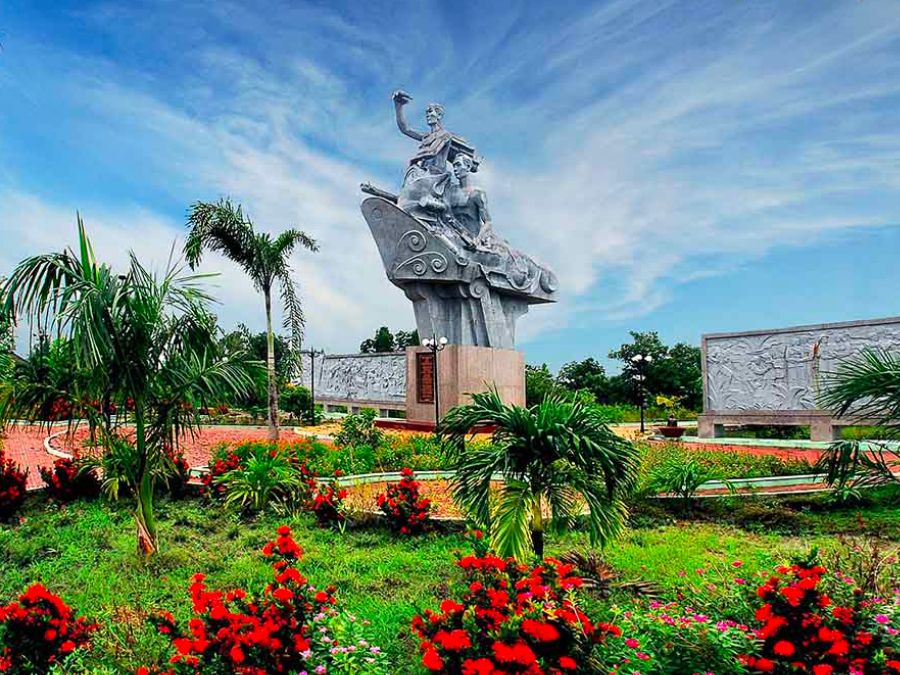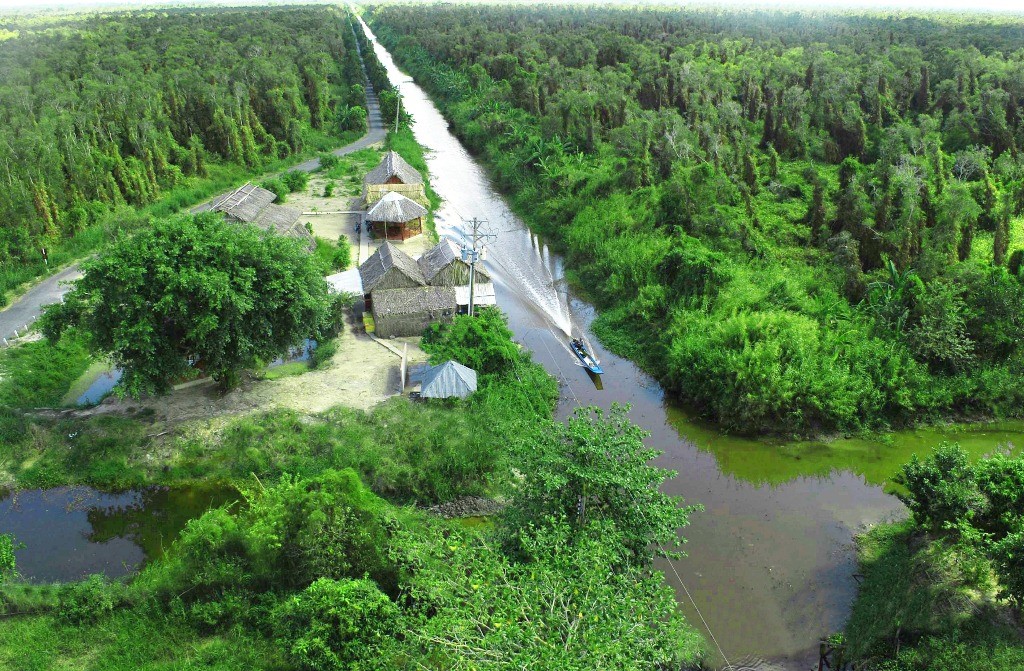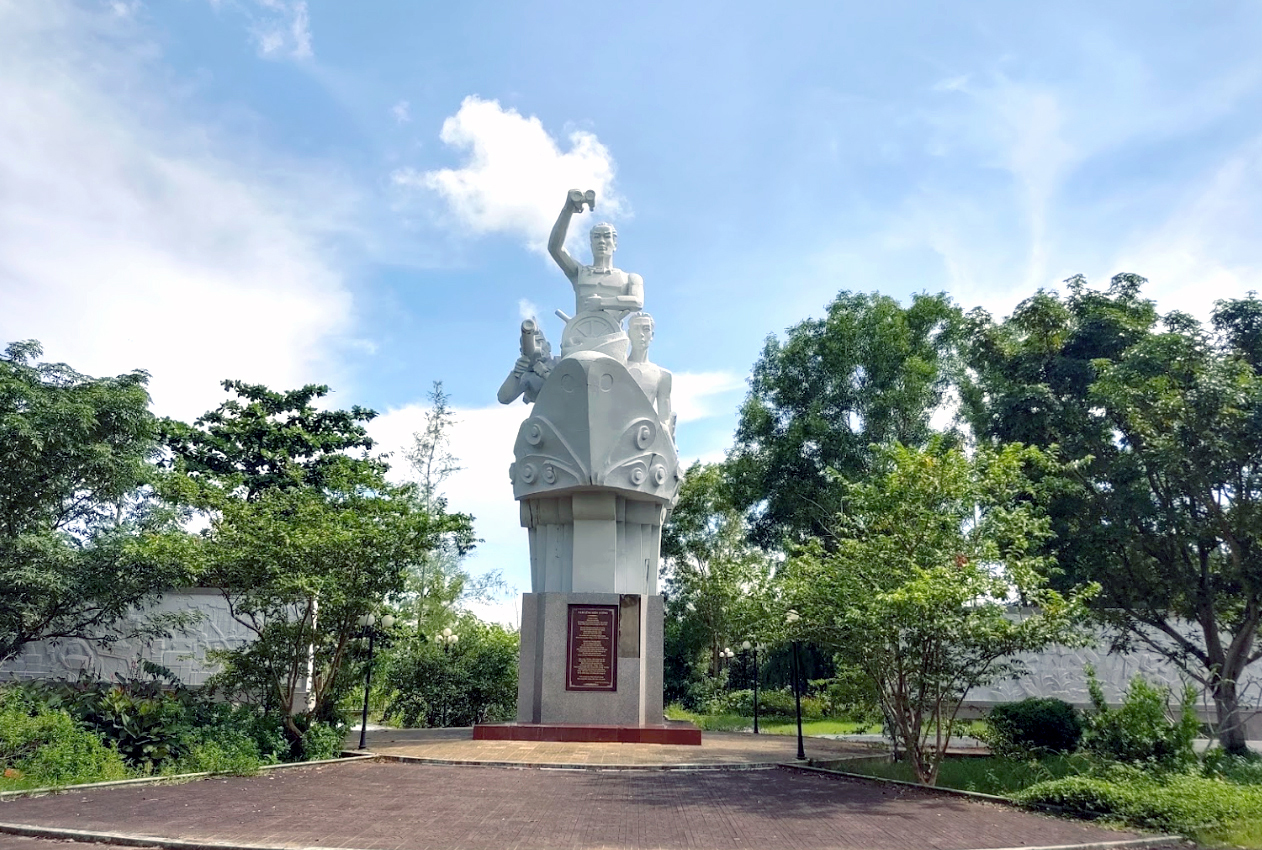Relic point Vietnam
Việt NamHong Anh Thu Quan Relic
Ca Mau, the southernmost land of the country, has a very valuable revolutionary historical relic, the Hong Anh Thu Quan, located at 43, Pham Van Ky Street, Ward 2, Ca Mau City. After a long period of fierce war, the relic still retains the original architecture of the original house, restored, embellished, and preserved in its original value. In January 1929, the Vietnam Association of Revolutionary Youth in Ca Mau town was established, with the important task of propagating Marxism-Leninism and educating revolutionary consciousness among farmers, workers, and students. , intellectuals and mass leaders fighting for people's rights and democracy. During that struggle movement, the Association opened the bookstore "Hong Anh Thu Quan" selling contemporary progressive books and newspapers published in Saigon. In fact, this is a front for the democratic movement, a meeting place for many patriots, and a place of operation for the Vietnam Revolutionary Youth Comrades Association of Ca Mau Town - a political organization with the mission of enlightenment. Enlighten patriotic youth, propagate and educate Marxist-Leninist ideology... The house with a construction area of 74m² (3.7m wide, 20m long) facing Northeast, adjacent to Ca Mau market, on the bank of Xang canal, is a street house in a 2-storey street block built by the French colonialists. Around 1900, it was called Asia's sleeping house (also known as Ong Son street). After a period of active operation, Hong Anh Thu Quan exerted a profound ideological influence on people from all walks of life, creating a political premise for the later birth of Communist Party establishments. With the meaning of being a pioneering flag in the revolutionary movement in Ca Mau, Hong Anh Thu Quan was ranked as a national historical relic on August 4, 1992. On the basis of inheriting traditional elements, the ground floor of the relic was restored to Tam Dong coffee shop in the form of socialization, decorated with many antiques and artifacts. Becoming an ideal Ca Mau tourist destination for tourists passionate about learning about the culture and history of Ca Mau land and a "red address" to educate revolutionary traditions for the young generation. Source: Ca Mau Tourism
Ca Mau 3751 view
Memorial area for musician Cao Van Lau
Located in Ward 2, Bac Lieu City, the Southern Don Ca Tai Tu art memorial area and musician Cao Van Lau were recognized by the People's Committee of Bac Lieu province as a provincial-level historical and cultural relic in 1997. 2014, the Ministry of Culture, Sports and Tourism ranked it as a national historical-cultural relic. With an area of nearly 12,500 square meters with a total investment of over 70 billion VND, this is the resting place of the family of the late famous musician Cao Van Lau. In addition, the relic site also has construction items such as the Southern Don Ca Tai Tu and Cai Luong art gallery, the Cao Van Lau musician exhibition hall and Hoai Lang Da Co version, the Don Ca performance hall. Southern amateurs, Musical Instrument Garden, Semi-moon Lotus Lake... Going through the main gate, visitors will see the "Yue Cam Dai Dai" standing tall in the middle of the campus. The staircase going up to the Dai Dai with 32 steps symbolizes the development of Da Co Hoai Lang village from beat 2 to Vong Co hamlet with beats 4, 8, 16, 32, 64. Above the highest Dai is the symbol of the Pliers. stylization - the symbol of Southern amateur music associated with the image of musician Cao Van Lau. The pliers are stylized from bamboo sticks, the pliers part is hollowed out to create mystery and sacredness, evoking nostalgia and remembrance of the deceased. On the Nguyet Cam Platform, there are 21 ornamental pots representing 21 provinces and cities where amateur music is strongly developed. Right behind the Nguyet Cam Station is a statue of musician Cao Van Lau sitting holding a Pliers instrument, behind him is Da Co Hoai Lang - this is his immortal work, known as the "King's song" of opera theater. Southern salary so far. Next to it is the Musical Instrument Garden with 12 types of traditional musical instruments carved in green stone. Going straight through the Musical Instrument Garden is the Art Gallery of "Don Ca Amateurs and Southern Cai Luong Theater". Visitors will be able to see and learn about many precious documents, images and artifacts related to the formation and development of the art of Don Ca Tai Tu and Southern Cai Luong theater. The most popular place for tourists is the Exhibition House of musician Cao Van Lau. This place stores many artifacts such as books, newspapers, documents, and images about the life and career of musician Cao Van Lau. In particular, here visitors will admire the wax statue of the late musician made of silicon, very similar to the real person. In addition to the above-mentioned projects, the memorial area for the late musician cannot help but mention, which is the grave of the late musician's family, in addition to a stage house for performing traditional folk music, The souvenir shop... has really attracted tourists when they set foot in this land. The memorial area of musician Cao Van Lau is truly the most attractive attraction in Bac Lieu. If you have the opportunity to visit Bac Lieu province, don't forget to visit the souvenir area. Source: electronic information portal of the Union of Friendship Organizations of Bac Lieu province
Ca Mau 5489 view
Ca Mau Steel Wire House
The Steel Wire House historical relic is located in the city center, located at the corner of Le Loi - Ly Bon street, cluster 3, ward 2, Ca Mau city. For young people today, the words "wire house" are quite strange. In fact, it is a post office built by the French colonialists around 1910 to perform the communication function to serve the ruling apparatus. and exploit their colonies. Taking advantage of the situation, the Vietnamese revolution turned this place into a communication hub between the Cochinchina Party Committee and the Ca Mau Party Cell in the resistance war against the French invasion. From 1930 to 1939, the Southern Party Committee and the Hau Giang Special Committee chose the Steel Wire House as the contact location. Comrade Le Ton Khuyen (an employee of the Steel Wire House) was assigned to be in charge of the Party's contact point. in Ca Mau area. From this contact point, the Ca Mau Party Committee received important news as well as timely direction to strengthen its forces and mobilize the masses to fight for the revolution and win many victories. The Steel Wire House Relic is not only a historical revolutionary relic of the province, but also a work marking the historical development of the transportation and communication industry in Ca Mau. Over time, the Steel Wire House was severely damaged, so in 1999, Ca Mau province agreed to rebuild it according to the prototype and in 2004, the house was inaugurated and put into use. Due to secret operating conditions, the relics in the relic can no longer be preserved, but currently the Ca Mau Provincial Museum has restored artifacts, documents, and images related to the relic, and at the same time displays them. Completely displayed at the monument, serving well for visitors to Ca Mau to visit and research. At the same time, it becomes a red address for traditional education for future generations to better understand the struggle of the Ca Mau people during the years of resistance against the French. On June 2, 2011, the Ministry of Culture, Sports and Tourism recognized the Steel Wire House in Ca Mau as a National Monument. Source: Ca Mau Tourism
Ca Mau 3701 view
Phat To Pagoda (Sac Tu Quan Am Ancient Pagoda)
Phat To Pagoda is located in Ward 4, Ca Mau city. The pagoda was built in 1840, bearing the ancient architecture of the 19th century. This is the earliest place to propagate Buddhism in Ca Mau. The original name of Phat To Pagoda is due to the long-standing respect of the people of Ca Mau region to the monk who built the pagoda: Venerable Thich Tri Tam. Legend has it that around 1840, Ca Mau area was a reed area. Following the flow of people going to reclaim the land, there was a young man, To Quang Xuan, who went to collect firewood in the forest. When the ax hit the trunk of an ancient Bodhi tree, a tree appeared. The Buddhist scriptures were placed at the base of the tree. From then on, the young man built a shrine to worship Avalokiteśvara while cultivating and taking medicine to treat people on the banks of Quan Lo canal. Legend has it that To Quang Xuan recited the Diamond Sutra to transform wild beasts. People who know the language come in large numbers to ask for medicine and learn religion. Among these disciples, even ferocious tigers also came to learn the Dharma. Currently, that tiger's tower still exists, and the disciples in the temple call it Su Cau's tower. Later, thanks to people's contributions, To Quang Xuan built a simple temple made of leaves. Seeing this, Do Van Vien in the area was jealous and accused him of being a dishonest Taoist. He was arrested by superiors and brought to Saigon (now Ho Chi Minh City) under house arrest. But To Quang Xuan's morality made the mandarins admire him. He was brought back to Hue and ordained as a monk at Kim Chuong Pagoda. Seven days after receiving the precepts, he passed away. The king ordained him as a "monk" and at the same time bestowed brocade and sent people to bring his remains back to Ca Mau. Feeling sorry for him, in 1842, King Thieu Tri (Nguyen Dynasty) decreed that To Quang Xuan be ordained as Venerable Thich Tri Tam, repaired his thatched hermitage next to the old forest and decorated the pagoda with the name " "The Four Avalokitesvara Ancient Temple". Venerable Thich Tri Tam is revered by the people in the area as "Buddha Patriarch", so the pagoda is also called "Buddha Patriarch Pagoda". Phat To Pagoda has been renovated many times, the major restoration was in 1937. However, the original state of the ancient pagoda is still basically maintained. Worship artifacts such as wooden statues, wooden trays, single vases, bronze bells, parallel sentences, ordained orders from the king... are still preserved, proving the development of Buddhism during the period when the Vietnamese people began to make strides. important in the work of reclamation and forming a communal society with the three ethnic groups Kinh, Chinese, and Khmer in the southern land. During the resistance war against America, Buddha Pagoda was a place to hide revolutionary soldiers. On November 24, 2000, Phat To Pagoda was recognized by the Ministry of Culture and Information as a national historical and cultural relic. In addition to the main architecture of the ancient temple, on the right from the temple gate, there is also the office of the Executive Board of the Buddhist Association, Ca Mau Buddhist Intermediate School, and the office of the Special Committee for Nuns. On the left of the main architecture, there is also the free Tue Tinh hall for the poor, the Buddhist Family Assembly Hall, the Sangha house... Every week, Buddhist studies and lectures are held here. Every year, on every major Buddhist festival such as the full moon ceremony in January, Buddha's birthday, Vu Lan... Buddha Pagoda becomes a place for festivals, a large number of monks, nuns, and Buddhists gather to attend. Source: Ca Mau Tourism
Ca Mau 5011 view
Southern Regional Party Committee - Central Southern Department
In Ca Mau province, there are currently 29 points belonging to the Southern Party Committee - Central Southern Department (period from late 1949 to early 1955) that have been ranked as historical relics by the Ministry of Culture, Sports and Tourism. nation. These locations are located in 7 districts and Ca Mau city including: Thoi Binh district has 11 points including: Central Office of the Southern Department; Central Radio Station of the Southern Department; Central meeting room of the Southern Department; Southern Command; Cipher Station of the Southern Command; Tran Phu Printing House; Southern Administrative Resistance Committee, Southern Radio, Nguyen Van Nguyen School; Agencies and organizations under the Southern Party Committee - Central Southern Department; Tran Quoc Toan School; Comrade Le Duc Tho's workplace; Department of Transport and Communications - Radio - Southern Radio Station. Nam Can district has 1 point: Southern Special Printing Department. Cai Nuoc district 1 point: Southern Administrative Resistance Committee. Dam Doi District 6 points: Southern Party Committee - Central Southern Department; Hall of the Southern Administrative Resistance Committee; Southern Department of Treasury; The Southern Party Committee School is named Truong Chinh; Propaganda Department of the Southern Regional Party Committee; Code Division of the Southern Regional Party Committee. Phu Tan district 3 points: Central Party School of the Southern Department named Truong Chinh; The place where the late General Secretary Le Duan put pen to paper to draft the "Southern Revolutionary Path", the precursor to the Party's 15th Central Resolution; Southern Administrative Resistance Committee. U Minh district 2 points: Southern Department of Health; Location of the Southern Department of Education from 1948 to 1954. Tran Van Thoi District 4 points: The Central Organizing Committee of the Department merged with the Military Organizing Committee; Tran Phu Printing House; Where the late General Secretary Le Duan stayed during revolutionary activities in Ca Mau; Gathering location to the North in late 1954 and early 1955 at Song Doc, Ca Mau province. Ca Mau City 1 point: Gathering location to the North in 1954 in Ca Mau. The above locations were ranked as national historical relics by the Ministry of Culture, Sports and Tourism on November 10, 2010 (including 5 relics) and October 28, 2016 (4 additional relics) . Source: Ca Mau Province Electronic Information Portal
Ca Mau 3535 view
Hon Khoai Relics
Hon Khoai is the name of a cluster of islands located southeast of Ca Mau cape in Tan An commune, Ngoc Hien district, Ca Mau province. Hon Khoai is more than 6 nautical miles (14.6km) from the mainland and has an important position in national defense and security. This place is considered a forward station guarding the air, sea and land in the southwest of the country. Hon Khoai Island includes many small islands: Hon Khoai, Hon Tuong, Hon Sao, Hon Doi Moi, Hon Da Le. Hon Khoai is the largest island with an area of about 4km2 and is also the highest island above sea level at 318m. In the past, this place was also known by many different names such as: Giang Huong Island, Doc Lap Island or Poulop Island during the French period. However, because of its shape like a giant potato, local people still call it Hon Khoai to this day. Hon Khoai is an island of rocks, hills and primitive forests that are almost intact with many precious woods and rich flora and fauna, which has captivated many tourists. According to the latest research, the flora in Hon Khoai has more than 1,400 species including fruit trees, timber trees, medicinal trees... Animals are also quite rich with monkeys, wild chickens, pythons, monitor lizards, squirrels. white... and more than 20 species of rare birds. Hon Khoai is known as the pearl island of cape land, surrounding forests and mountains, gentle blue sea water and relics tinged with time. This place has become an attractive destination that tourists cannot miss when coming to Ca Mau province. In September 2013, the Hon Khoai island cluster was set the record for the island cluster closest to the equator. The history of Hon Khoai relic also tells about the 12.05m high lighthouse built by the French colonialists on the peak of the island. This lighthouse has a scanning capacity of 35km wide; is part of the Can Gio - Con Dao - Hon Khoai - Phu Quoc lighthouse system to help illuminate ships traveling in the East Sea. On December 13, 1940, this place marked an important historical event when Mr. Phan Ngoc Hien led the uprising at Hon Khoai against the French colonialists and won. This is also the day chosen as the Revolutionary Tradition Day of the Party Committee and people of Ca Mau to commemorate this important event. Hon Khoai has a long, sheltered coastline, an anchorage and storm shelter for fishermen and a breeding and sheltering place for many marine species. From tiny plankton species to aquatic species with high economic value such as: squid, lobster, mantis shrimp, grouper, cobia,... Hon Khoai beach has wide sandy beaches. When the tide is low and the sea is calm, visitors can walk on the sand to learn about marine life and breathe the fresh air of the forest and sea. On April 27, 1990, Hon Khoai Relic was recognized by the Ministry of Culture, Sports and Tourism as a national historical and cultural relic. Source: Ca Mau Province Electronic Information Portal
Ca Mau 3946 view
Cao Dan Pagoda historical site
Saraymel Chey Pagoda (Cao Dan Pagoda) is located in hamlet 7, Tan Loc commune, Thoi Binh district, Ca Mau province. Cao Dan Pagoda is located next to Highway 63 (in hamlet 7, Tan Loc commune, Thoi Binh district), about 16 km north of Ca Mau city center. Cao Dan Pagoda was built in 1922 on an area of 4 hectares, at the intersection of Duong Cay canal, donated by Mrs. Diep Thi Lai. At that time, people often called Chau Trang Pagoda (Bach Nguuu). After being burned by the enemy many times, in 1998, Cao Dan Pagoda was newly built. Inside the main hall of the pagoda there is a large altar, worshiping only Shakyamuni Buddha. Opposite the main hall is the Venerable Huu Nhem tower, built in 2003, 17m high, 12m² area. In 1954, the Geneva Accords were signed, we had to bring a group of core officers and children to the North, choosing Cao Dan Pagoda as the study center for the core officers and children. rolled in the province to send to the North. The remaining core cadres used their legal positions to the fullest extent; the cadres who had not yet been exposed were infiltrated into the enemy's ranks. The number of officials revealed to be roaming the operating area or withdrawing into secret. Revolutionary organizations were also reorganized and transformed to suit the situation at that time. On the other hand, Cao Dan Pagoda was directed by the Party to move next to bridge highway No. 6 (National Highway 63), to avoid enemy observation. At the same time, there are people's houses as security shields to make operations easier. During the two resistance wars against the French and the Americans, the Board of Directors and the monks and Buddhists of Cao Dan Pagoda were closely associated with the revolution. Cao Dan Pagoda is the secret base of the revolution. Among them, Venerable Huu Nhem, former abbot of the pagoda who passed away during the resistance war against the US, held the position of Vice Chairman of the National Front for the Liberation of the Southwest Region, actively campaigning for monks and the Management Board. ruled over pagodas and a large number of local Kinh - Hoa - Khmer ethnic people participated in the resistance war against the Americans to save the country. The enemy repeatedly bombed and destroyed the temple; Many monks and Buddhists heroically sacrificed their lives. Today, at Cao Dan Pagoda there are still many unfilled bomb craters, proving that the enemy's destruction cannot overshadow the rebellious and patriotic spirit of Buddhists and monks. During the process of formation and development, Cao Dan Pagoda has not only performed the task of maintaining religion, but also performed well the tasks of a patriotic citizen, always attached to the nation and the leadership of the Party and the strong revolution that has been created. The results are very appreciable. At the same time, we must not separate from the great national unity bloc to participate in the struggle against French and American invasion, contributing to completely liberating the South and reunifying the country. On December 29, 2017, Cao Dan Pagoda was decided to rank as a national monument by the Minister of Culture, Sports and Tourism. Source: Ca Mau Province Electronic Information Portal
Ca Mau 4888 view
Dam Doi - Cai Nuoc - Cha La historical relic area
The victory site of Dam Doi - Cai Nuoc - Cha La, belongs to Cha La hamlet, Tran Phan commune, Dam Doi district, Ca Mau province. In September 1963, the Regional Party Committee, the Military Region Command (T3), the Provincial Party Committee and the Military Command of Ca Mau Province advocated opening a military attack campaign, aiming to destroy and destroy enemy forces and support the enemy. The masses rose up and expanded the liberated zone in South Ca Mau. Cai Nuoc and Dam Doi were two sub-districts (district capitals) in the south of Ca Mau, 20km apart, chosen as the main targets. The Military Region Command decided to destroy Dam Doi and Cai Nuoc Sub-Regions in one night, attack surrounding posts, and block enemy reinforcements. At the same time, step up attacks on enemy rear bases, airports, and command posts in Can Tho, Soc Trang and other provinces. Attack the enemy with 3 armored attacks, uproot fortresses, and destroy strategic hamlets. The time for shooting to destroy the two branches was uniformly determined on the night of September 9 and early morning of September 10, 1963. Dam Doi and Cai Nuoc Branch, built with a solid structure since 1955. This place became a place of strict defense of the enemy with a complex protection system; including steel barricades, minefields, and strategic watchtowers, etc. At Dam Doi Branch, U Minh Battalion 1 conducted a courageous and intelligent attack strategy. After two fierce hours, the army and people here destroyed the Dam Doi war zone, destroyed 110 enemies, captured 48 alive and seized many military weapons. The victory at Cai Nuoc was no less impressive. Battalion 306 attacked strongly on the night of September 10, 1963. As a result, 92 enemies were destroyed, 84 were captured and many important military weapons were captured. Cha La is also a location that suffered a comprehensive attack by our army. After more than 3 hours of fierce fighting, our army destroyed the Cha La base and completely defeated the enemy. The result was the capture of 30 enemies and the seizure of many types of weapons. These battles not only destroyed the enemy but also contributed to destroying the US military's "helicopter and parachute" strategy. Those victories not only expanded the liberated area; but also the clearest testament to the strength and fighting spirit of the Southern army and people in the war against America to save the country. The victory of Dam Doi - Cai Nuoc - Cha La was a great success of our army and people in implementing the "two legs, three prongs" approach (armed - political - political - military), promoting strength. The synthesis of the people's war, the victory of Dam Doi - Cai Nuoc - Cha La were two of the seven major victories of the Southern army in 1963. We destroyed many enemies, removed many posts and destroyed every hamlet. strategy, the liberated area was expanded, the Cha La battle not only eliminated the enemy from the battle but also contributed to defeating the US-puppet "helicopter and parachute" tactic. On August 18, 2016, the historical relic Dam Doi - Cai Nuoc - Cha La victory site was decided to rank as a national historical relic by the Ministry of Culture, Sports and Tourism. Source: Ca Mau Province Electronic Information Portal
Ca Mau 4253 view
Vo Doi Forest Village relic site
Location Vo Doi forest village, Vo Doi hamlet, Tran Hoi commune, Tran Van Thoi district, Ca Mau province. Currently, Vo Doi Forest Village Site has become U Minh Ha National Park and is located in the Ca Mau Cape World Biosphere Reserve. Vo Doi Forest Village was established in the late 50s of the 20th century. After the Geneva Agreements, the US imperialists increased the construction of their minion ruling apparatus to turn South Vietnam into their new-style colony. In Ca Mau, the Ngo Dinh Diem government also began sending troops to close garrisons everywhere in the province and set up a high-ranking apparatus from the province to the communes and hamlets that were previously liberated areas to carry out arrests. terrorize those participating in the resistance, restrain and oppress the people, and destroy the revolutionary forces. At the same time, America and Diem increased the concentration of people into "residence areas" and "dense areas", organizing population control in many very strict forms with the purpose of separating revolutionary cadres and "separate" people. fish out of water", causing the masses to distance themselves from the revolution, blocking supply sources and isolating and eliminating our cadres and soldiers. The "dense zones" and "residences" were set up by the enemy with hundreds of taboos and coercion to control people's lives, so when the Party's policies showed the way, the masses wholeheartedly supported them. , they left their old village and went into the forest to establish a new village to respond to the Party's call and stand up for revolution. Vo Doi forest village was formed with hundreds of stilt houses built of melaleuca wood concentrated in residential clusters on high mounds in the forest. From the market, if you want to get to the forest village, you have to go through many canals. Go to the edge of the forest to see the receiving station. From there, you have to walk through the forest for 7-8 km to reach the base. Houses in forest villages usually have an area of 20 - 25m2, with crowded houses the area is 40 - 50m2, built entirely of Melaleuca trees, Melaleuca planks, and roofs made of Melaleuca bark. To protect the base, people went to distant forests, selected large melaleuca trees and when peeling the bark, left a thin layer of bark close to the trunk so that the tree would not die. Cut cajuput bark about 0.6 - 0.8m long. When spread out, the width is about 0.4 - 0.5m, the roof can last for 2 - 3 years. There are some houses that use the leaves of the Mandarin tree (leaves that make hats) to form sheets for roofing and walls. The folding houses are covered with plastic roofs and covered with leaves, for short-term temporary residence. Houses that have the means to discharge Melaleuca boards, foam, etc. to line the floors. From one house to the other is bridged by cajuput trees. Next to each house, there is a drinking water well. This well does not have to be dug, but using a knife to cut off the surface layer of tree roots about 1m2, scrape off the leaves and compost it to get water. Further steam wells do the same but are larger and are used for bathing and washing. In the dry season, dig 0.4 - 0.5m deep to get water. Almost no house has water storage equipment such as jars, jars, containers... Regarding the organization of the forest village, in addition to the village elements, a management board with a commander, leadership organization, activities, protection, and strength building... such as party cells and branches are formed. Mass organizations, production groups, guard groups, construction site groups (weapon making), medical groups, education groups, arts groups... In the forest village, the military and people's love is a unified block, everyone People who only think about the common good, for the common good, put the interests of the revolution first. Forest Village existed until 1960, when the Dong Khoi movement was launched, our revolutionary forces in Forest Village combined with outside revolutionary forces to simultaneously attack the enemy, liberating many rural areas in the province. After Dong Khoi, the armed forces spread out and the people returned to their old hometowns to make a living, continuing to contribute to the revolution in human strength and wealth in the new period. On June 20, 2018, the Ministry of Culture, Sports and Tourism ranked Vo Doi Forest Village as a National Monument. Source: Ca Mau Province Electronic Information Portal
Ca Mau 3723 view
Vam Lung Pier No
Ben Vam Lung Khom 8 historical site, Rach Goc town, Ngoc Hien district, Ca Mau province. This is the place to record the silent victories of the soldiers on the "Unnumbered Train" that crossed thousands of kilometers by sea, transporting weapons to support the Southern battlefield during the years of resistance against the US to save the country. created the miracle of the Ho Chi Minh Trail at sea. Due to pressing requirements for weapons and ammunition to be supplied to the Southern battlefield, the Politburo and the Central Military Commission instructed the Southern provinces to prepare yards and organize forces to receive weapons from the region. North for the South. Vam Lung Cua is the name of the local people, on the map it is written as Nang River, originating from the East Sea, outside the coast there is mud flats, on the right side is Xeo Lo canal. Vam Lung gate is over 100 m wide and has a water depth of 4-5 m, convenient for ships carrying over 30 tons to enter and exit easily. On October 11, 1962, the first train of the "unnumbered train", bearing the name "Phuong Dong 1", carried 30 tons of weapons from Do Son wharf, Hai Phong, opening the way to the South. On October 16, 1962, the ship Phuong Dong 1, commanded by captain Le Van Mot and political officer Bong Van Dia, crossed thousands of nautical miles under the surveillance and siege of enemy ships but still safely docked at Vam Lung. . This is the train of the "Train without number" opening the strategic transport route in the East Sea - the Ho Chi Minh sea route. After the successful return of the ship "Phuong Dong 1", the ships "Phuong Dong 2", "Phuong Dong 3", "Phuong Dong 4" continued to dock at Vam Lung Wharf to bring hundreds of tons of weapons from the region. The North moved in to support the Southern battlefield. By the end of 1970, Ben Vam Lung received over 70 ships with more than 4,400 tons of weapons and ammunition. Thanks to the rugged terrain, along with a network of canals and canals, above are covered with mangrove and fish sauce forests, creating ideal conditions for revolutionary soldiers to easily transport and hide weapons. Besides, the support and protection of the Rach Goc People are like "iron citadels and bronze citadels" to protect the revolution. Thanks to that, for more than 10 years of operation (1962-1972), our operating bases were safely protected, even though they were located not far from the enemy's military zone in Nam Can. Ben Vam Lung historical site is also associated with the birth of the military unit with the name "Group 962" (established on September 19, 1962) with the task of protecting the safety of trains. entering and exiting the yards, secretly receiving and hiding weapons and transporting weapons to liberation army units for combat purposes. Group 962, later Regiment 962, was twice awarded the title "Hero of the People's Armed Forces" by the State. Due to special requirements during the war period, it was necessary to maintain absolute secrecy and safety for activities of organizing the transportation of weapons, military equipment, and military supplies from the North to support the Southern battlefield, so the artifacts is not kept. However, there is still a damaged wreck of ship 69 of convoy 962, located at Xeo Gia peak about 8 km west of the wharf. To remember and honor the resounding and immortal victories of the Numberless Train, the Ho Chi Minh Trail Victory Monument at sea; A house displaying traditional documents and a number of related works were built at Ben Vam Lung. On October 23, Ben Vam Lung Historical Relic Area was recognized by the Ministry of Culture, Sports and Tourism as a national historical site. Source: Ca Mau Tourism
Ca Mau 3989 view
